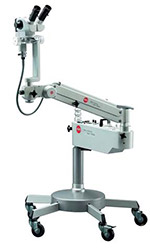Colposcopy / Cervical Pathology
Dr Urbaniak is a Certified Colposcopist, a Member of The Australian Society for Colposcopy and Cervical Pathology (ASCCP) and participates in the Colposcopy Quality Improvement Program (C-Quip).



- What is colposcopy?
- If your PAP smear is abnormal, or if the appearance of the cervix or any other symptoms are raising concerns, your Doctor will refer you for a colposcopy. This is an office investigation, similar to a PAP smear, which is performed with a speculum. The colposcopist will look at the cervix with a magnifying binocular called a colposcope (see picture) to identify any abnormalities. To help this process, a weak solution of pure medical vinegar is applied to the cervix. If an abnormality is seen, a small 2-millimetre sample of tissue (a biopsy) will be taken and sent to the laboratory for an examination under the microscope (a histology). Taking the biopsy is not painful and does not require an anaesthetic. The whole colposcopy takes about ten minutes. The result of the biopsy is available within a week. After the result is known, management plan will be made, either to have a conservative follow up, or to treat it surgically.
- New cervical screening programme
- As we now know, nearly all cases of cervical pre-cancer and cancer are caused by a sexually transmitted infection of the genital tract called Human Papilloma Virus (HPV). There are about a hundred types of HPV, most of which cause a benign self-limiting reaction. In fact, nearly 80% of the Australian population has evidence of past HPV infection. Only certain types of HPV, called high risk HPV, have the potential to remain in the cervix in a few percent of women and may eventually result in progression to cervical pre-cancer. Those women are identified by screening for high risk HPV. Compared with the PAP smear, HPV-based screening has a higher pickup rate of abnormalities, and only needs to be carried out every five years. Australia will be introducing HPV-based screening in May 2017, and for most women screening will start at the age of 25. The new cervical screening program is offered in conjunction with HPV vaccination for girls and boys, which is already operational and successful in reducing the number of HPV-caused cervical abnormalities.
- What is cervical screening?
- Cancer of the uterine cervix remains a major risk to women’s health. In Australia, over 700 women are diagnosed each year with cervical cancer. The process of cervical cancer growth occurs over several years and is preceded by certain early pathological stages called pre-cancer. Cervical screening programs are aimed at the detection and treatment of pre-cancer, to prevent the development of frank cervical cancer. The current screening program relies on regular two-yearly cytology sampling, that is, taking a PAP smear.
- Treatment at the SAN Hospital and Hornsby Hospital
- Dr Urbaniak offers treatment at the SAN Hospital and at Hornsby / Ku-Ring-Gai Hospital, both for privately insured as well as Medicare patients. Surgery for cervical abnormality is a minor procedure requiring day admission to the hospital. Under anaesthesia, the small fragment of the cervix containing the abnormality is removed: this is called LLETZ (Large Loop Excision of the Transformation Zone) or LEEP (Loop Electrosurgical Excision Procedure). The treatment is highly effective and complications are infrequent.


